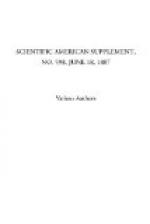[Illustration: Fig. 2., Fig. 3. & Fig. 4.]
Fig. 2 shows the blades for the A screw. C and D have the same form. Fig. 3 shows in full lines the blades of the B screw, and, though very narrow at the tips, they, like A, are after the Griffith pattern. The blades of E and F are of a similar shape, as shown in Fig. 4, and approach an oval form rather than the Griffith pattern. The particulars of these propellers would be considered incomplete without some reference to their positions with respect to the hulls. When deciding the positions of twin screws, there is room for variation, vertically, longitudinally, and transversely. For these screws, the immersions inserted in the table give the vertical positions. The immersion in A is 9 ft., showing what may be done in a deep draught ship with a small screw. Whatever the value of deep immersion may be in smooth water, there can be no question that it is much enhanced in a seaway. The longitudinal positions are such that the center of the screw is about one-fifth of the diameter forward of the aft side of the rudder post. The positions may, perhaps, differ somewhat from this rule without appreciably affecting the performance, but, if any alteration be made, it would probably be better to put the screws a little farther aft rather than forward. The forward edges of the blades are from 2 ft. to 3 ft. clear of the legs of the bracket which carries the after bearing. The transverse positions are decided, to some extent, by the distance between the center lines of the engines. As regards propulsive efficiency, it would appear that the nearer the screws are to the middle line, the less is the resistance due to the shaft tubes and brackets, and the greater is the gain from the wake in the screw efficiency, but, on the other hand, the greater is the augment of the ship’s resistance, due to the action of the screws. Further, the nearer the screws are to the hull, the less are they exposed. But experience is not wanting to show that the vibration may be troublesome when the blades come within a few inches of the hull. The average of the clearances between the tips of the blades and the respective hulls is about one-eighth of the diameter of the screw.
An interesting and noteworthy fact in connection with these propellers is the wide differences in the pitches and revolutions, though the products of the two do not greatly vary. Such differences are extremely rare in the mercantile marine for similar speeds, but in war ships they are inseparable from the conditions of the engine design. As a general rule, with (revolutions x pitch) a constant, an increase of revolutions and the consequent decrease of pitch allow a diminution of disk and of blade area—other modifying conditions, such as the thrust, slip, number, and pattern of blades, being the same. The screws for E and F are interesting, because, with practically the same speeds and slips, there is a considerable




